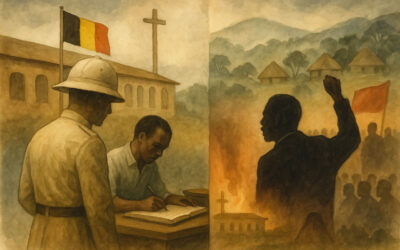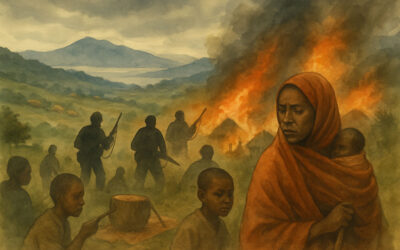Colonel Aloys Ntiwiragabo was found in 2020 near Orléans in France after evading international justice for 26 years. He is the main architect of the denial of the Tutsi genocide. He was particularly involved in manipulating the French justice system in relation to the attack on 6 April 1994. Episode two.
On the evening of 6 April 1994, two missiles were fired at the plane carrying Rwandan dictator Juvénal Habyarimana and Burundian President Cyprien Ntaryamira, which was preparing to land in Kigali, the capital of Rwanda. All those on board, including both heads of state, were killed in the attack. The shooters opened fire from a Rwandan army camp. A military coup that paved the way for a genocide that would claim more than a million lives. For two decades, the identity of those responsible for the crime was at the centre of a vast distraction campaign.
In 2020, Mediapart found the former head of Rwandan military intelligence, Aloys Ntiwiragabo, in the Loiret region, France, where he still resides. He appears to have been at the heart of the 6 April 1994 conspiracy, as recounted in the first episode. Over the following decades, the master spy concocted an alternative narrative of events and misled French parliamentarians and magistrates.
The architect of denialism
The day after the assassination of the Rwandan president, Rwandan soldiers murdered the prime minister and ten Belgian peacekeepers who were supposed to be protecting her at dawn. This prompted Brussels to recall its military personnel deployed in Rwanda as part of a peacekeeping mission.
In the summer of 1995, Belgium issued arrest warrants for senior Rwandan officers in exile whom it considered responsible for the deaths of its ten peacekeepers. Aloys Ntiwiragabo then wrote a brief “denial” of what he called “false accusations”. According to Ntiwiragabo, the Belgians died “by chance” in a situation that was “already irreversible and uncontrollable” due to the “anger” of Rwandan soldiers. He also claimed that the peacekeepers and rebels were “the prime suspects in the assassination of the president“. Colonel Ntiwiragabo seized the opportunity to present himself as holding “at least part of the truth” that could “enlighten the International Tribunal”.
Four texts Ntiwiragabo wrote subsequently laid the foundations for all denialist theories that have been put forward to this day. The fallacious arguments and alternative facts he used to support his narrative are still employed in all works that deny, downplay or trivialise the Tutsi genocide.
In December 1995, Colonel Ntiwiragabo wrote an extensive document presented as a “contribution to the search for truth” and drafted as an indictment of the new Rwandan government. The 242-page document was intended to defend the perpetrators of the genocide before the International Criminal Tribunal for Rwanda (ICTR), which was set up by the United Nations to try those primarily responsible for the genocide. A year after its completion, a “former Rwandan soldier” provided a copy of the document to the defence attaché at the French embassy in Nairobi, Kenya. The attaché then forwarded the file by “accompanied courier” to the Military Intelligence Directorate (DRM).
Between 14 May and 30 June 1997, Aloys Ntiwiragabo then wrote three further negationist texts totalling 40 pages in Nairobi. These dealt specifically with the attack on the Rwandan dictator on 6 April 1994, the assassination of the Prime Minister, and the murder of ten Belgian peacekeepers on 7 April 1994.
It was in France that these forgeries first gained an audience. On 3 March 1998, the National Assembly established a parliamentary fact-finding mission regarding French operations in Rwanda between 1990 and 1994. Colonel Ntiwiragabo signed a handwritten letter which African Facts was able to consult. Addressed to the president of the institution (Laurent Fabius at the time), it had the subject line “France, victim of malicious denunciation in the Rwandan tragedy”. In that letter, he praised “the rather beneficial role of the French government in the Rwandan crisis” and denounced “distorted truths”, “a media and diplomatic embargo”, and a “lobby” that had “poisoned and manipulated international opinion in order to mobilise it against the Hutu people”. According to Ntiwiragabo, France was “misunderstood”. “The other powers […] seem to have formed a coalition against France to hold it responsible for the Rwandan tragedy”, he wrote.
The MPs quickly got hold of other writings by Aloys Ntiwiragabo that were in the DRM’s possession. On 19 May, a Belgian mercenary who was questioned in closed session backed up the version of events given by the Rwandan colonel and said that Ntiwiragabo had given photographs to the French authorities. On 2 June, the DRM sent MPs photographs of the missile launchers allegedly used to shoot down the Rwandan president’s plane. However, these photographs do not show the weapons used in the attack. They were taken by Aloys Ntiwiragabo’s team for the express purpose of covering up the evidence. The colonel sent them to Paris in the midst of the genocide.
Published on 15 December 1998, the French parliamentary report gave prominence to the false hypothesis that rebels had carried out the attack using these missile launchers. But Colonel Ntiwiragabo did not stop there.
Judge Bruguière’s Whisperer
In parallel with the parliamentary mission, a judicial investigation regarding the 6 April 1994 attack was initiated in France in March 1998, following a complaint filed by the families of the French pilots. The former Rwandan presidential family, who had recently settled in France by that time and to whom Aloys Ntiwiragabo was close, quickly became the main force behind this procedure.
For sixteen long years, this judicial case formed the cornerstone of a substantial diversionary operation. It was based on a truncated, but simple, narrative that presented the attack of 6 April 1994 as the trigger for the Tutsi genocide – i.e. the extermination of a million people was supposedly a spontaneous reaction to this event. According to this reasoning, those who shot down the plane were de facto responsible for the genocide. However, this was a fallacious construct based on a grotesque begging of the question – the genocide had actually been planned long in advance, and the attack merely provided the starting signal. Nevertheless, this theory gained considerable traction among magistrates, civil servants, politicians and some journalists. This flawed narrative, instilled by a handful of individuals acting in the shadows – foremost among them Aloys Ntiwiragabo – would act like slow poison on public opinion.
The investigation into the 6 April 1994 attack was entrusted to anti-terrorism judge Jean-Louis Bruguière. Between 14 December 1999 and 9 June 2001, Colonel Ntiwiragabo sent the investigators and magistrate his five texts. These documents aroused their keen interest, as evidenced by a series of police reports consulted by African Facts.
The colonel’s writings piqued the investigators’ curiosity even further because, during the same period, a French officer who had been in Rwanda in 1994 testified at his hearing about a message claiming responsibility for the attack. The colonel’s texts also mention this. And with good reason: it is in fact a forgery, fabricated by Aloys Ntiwiragabo prior to the attack. The investigators eventually got hold of the message and transcribed it in their report. The French Ministry of Defence then provided them with photographs of the missile launchers that were allegedly used to shoot down the plane and which had been taken by Colonel Ntiwiragabo’s department.
On 9 July 2001, Jean-Louis Bruguière flew to Kinshasa in the Democratic Republic of Congo to interview Aloys Ntiwiragabo. The judge claims to have no recollection of this meeting. “I don’t know anything about this person, and even if I did, I wouldn’t comment,” he told African Facts.
At the time, Aloys Ntiwiragabo was leading an armed group that he had created himself: the Democratic Forces for the Liberation of Rwanda (FDLR). This paramilitary organisation commits war crimes and crimes against humanity in the Democratic Republic of Congo. One of the French judge’s main witnesses and informants was Christophe Hakizabera, the FDLR’s emissary in Europe. “We didn’t care that they were part of this organisation; we were questioning them in connection with the attack. The FDLR was not our problem”, says a former Interior Ministry official who was once close to the case. According to him, the matter simply concerned Ntiwiragabo and Hakizabera’s “political opinions” and was not their concern.
The individual whom the anti-terrorism magistrate and French investigators met in Kinshasa in summer 2001 was officially wanted by the International Criminal Tribunal for his alleged involvement in the 1994 Rwandan genocide. But that didn’t seem to bother them either. “A witness is a witness. So we proceed with his hearing. Whether he is wanted or not is irrelevant. In any case, we don’t have the power to arrest him there. We have no jurisdiction to arrest someone in a foreign country,” said our source, who participated in the investigation.
Aloys Ntiwiragabo provides the French magistrate with providential testimony. The former head of the G2 service fills in the gaps in a scenario he invented a few years earlier, which he has patiently distilled to the judge over the previous years. In 2006, Jean-Louis Bruguière issued an order entrenching Colonel Ntiwiragabo’s fable aas well as nine arrest warrants against former rebels who now govern Rwanda.
However, it took another twelve years for the case to be dismissed in 2018 by other magistrates, after they had unravelled the imaginary scenario concocted by the master spy. Ballistic and acoustic expertise carried out on site determined that the shots fired at the president’s plane came from a camp belonging to the regular Rwandan army. Jean-Louis Bruguière, who describes this case as “sensitive”, told us that he did not want to “give the impression of taking an interest in it again or of being partisan and controversial”. When we contacted Aloys Ntiwiragabo’s lawyer, he asked us to “stop bothering” his client.



